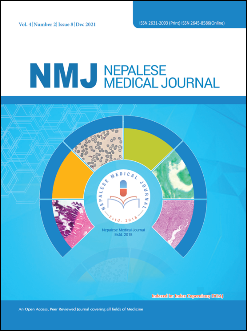Spectrum and Presentation of Urinary Bladder Growth: a Single-Center Retrospective Study
DOI:
https://doi.org/10.3126/nmj.v4i2.42055Keywords:
Cystoscopy, Hematuria, Urothelial NeoplasmAbstract
Introduction: Urinary bladder cancers are heterogeneous diseases consisting of a divergent group of tumors. Diseases of the urinary bladder, both neoplastic and nonneoplastic contribute to notable mortality and morbidity. Histopathology remains the gold standard of diagnosis. Bladder transurethral resection of the tumor is a therapeutic procedure that ensures the material necessary for histopathological diagnosis because it allows assessment of the degree of differentiation, depth of tumor invasion, parameters useful in the elaboration of diagnosis and prognosis assessment
Material and Methods: All the urinary bladder biopsies submitted in the pathology laboratory during 1 year time period were included in the study.
Results: Among the 51 total cases in the study, the male to female ratio was 4.67:1 with the age group of 22-96 years. Among the study population, 30 (52.7%) presented with hematuria, 10 (19.2%) with burning micturition, frequent urination, and lower abdominal pain. In the study, 44 (86%) showed neoplastic lesions while 7(14%) remaining were non-neoplastic lesions. Infiltrative urothelial carcinoma with low and high grades was diagnosed in 23% (12/51)
Conclusions: This study has revealed that neoplastic lesions are more common than non-neoplastic lesions. A great majority of neoplastic lesions are of urothelial origin. Majority of which are invasive urothelial neoplasm. All urothelial neoplasms are more common in males. Cystoscopic studies and biopsies help in the early detection of bladder neoplasms and they form the mainstay of the diagnosis and follow-up.
Downloads
Downloads
Published
How to Cite
Issue
Section
License
Copyright (c) 2021 Deliya Paudel, Himanshu Regmi, Uspal Bajracharya, Guna K Shrestha

This work is licensed under a Creative Commons Attribution 4.0 International License.
This license enables reusers to distribute, remix, adapt, and build upon the material in any medium or format, so long as attribution is given to the creator. The license allows for commercial use.
Copyright on any article published by Nepalese Medical Journal is retained by the author(s).
Authors grant Nepalese Medical Journal a license to publish the article and identify itself as the original publisher.
Authors also grant any third party the right to use the article freely as long as its integrity is maintained and its original authors, citation details and publisher are identified.




